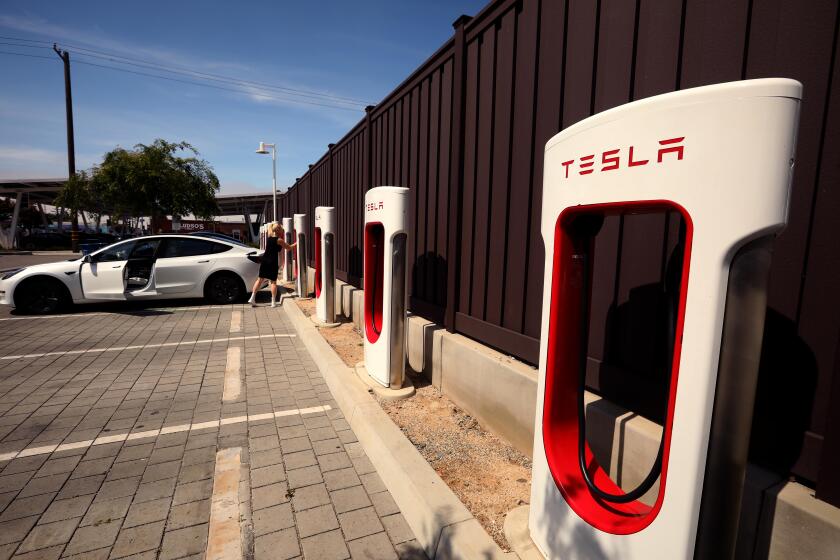Driving head-on into debt
The nation’s highways are packed with wonderful new cars and trucks that are purchased by people who seem rich and happy. But, in fact, many are deep over their heads in debt.
A cycle of ever-growing consumer debt, which is allowing people to own cars they cannot afford, keeps auto manufacturers humming and stokes sales teams at many dealerships.
But an important California appeals court ruling this month threatens to throw a tire iron into the machinery of this Byzantine system.
About 25% of new car sales involve trade-ins of older cars that are worth less than the loan amounts carried by the owners, according to Edmunds.com, a situation known as negative equity. The owners are said to be “upside down.” In fact, the entire situation is upside down.
At a quaint time in history, a trade represented an asset that the owner had built up by paying off the loan. That’s almost a laughable concept today.
Loans on cars have grown longer and longer. Now, the average loan is more than 60 months. In some cases, vehicle loans are extended out eight years. “We are getting further and further into debt, sinking into negative equity,” said Rosemary Shahan, executive director of Consumers for Automotive Reliability and Safety, a Sacramento advocacy group.
By the time a lot of car owners with loans want to dump their car, the negative equity can be huge. Edmunds data shows that on average these cars are underwater by $3,668 at trade-in.
It should be an impediment to getting a new loan, but some dealers have found a way around the problem. They finance the negative equity in the loan on the new car by increasing the stated cash value of the new car.
Nice and simple, but the way they are doing it is illegal, at least in some cases, according to a decision by California’s Fourth Appellate Division.
The court affirmed an earlier decision in a case brought by Reta Thompson, who decided to trade in her late husband’s recreational vehicle and buy a newer used model. The old RV however, had an estimated $16,000 of negative equity. The dealer, 10,000 RV Sales in San Diego, allowed an $8,000 positive trade-in and then increased the price of the new RV by $24,000.
On the loan disclosure statements, it listed the new RV as having a cash price of $93,398, rather than its actual cash value of $69,398, according to the 38-page court decision. The widow claimed she did not know about any of this, and her attorney, Hal Rosner, argued successfully that it violated the federal Truth in Lending Act. “The standard contract has a place to list negative equity, but a lot of dealers don’t use it,” Rosner said. “The lenders think the buyer is putting down hard cash.”
One clear problem with the approach was that the widow had to pay sales tax on the $24,000 of phantom value, adding about another $1,800 to her loan and an additional $2,157 in interest over the term of the contract.
The case was seen as crucial by the auto industry. Briefs were filed in support of the system by the California Motor Car Dealers Assn. and the California RV Dealers Assn. The appeals panel brushed aside those arguments.
In the appeal, executives at 10,000 RV Sales acknowledged that they were increasing the trade-in prices routinely to eliminate the appearance of negative equity on sales contracts, saying lenders require a certain down payment and prefer a buyer not to have negative equity, according to the decision.
A lower court in San Diego found the whole arrangement was a common practice at the dealership and was an intentional fraud. The decision revoked the contract and granted punitive damages. The California Motor Car Dealers Assn. says it does not agree with the approach taken by 10,000 RV Sales and believes that negative equity should always be clearly disclosed on sales documents. But it backs the right of consumers to carry negative equity into transactions.
“We urge dealers to follow the law and expect them to do so,” spokesperson Marcella Rojas said.
Though the appellate decision was a big win for consumers, there is broad concern about negative equity.
“More and more consumers are rolling negative equity into new car loans,” said Phil Reed, an expert on car transactions at Edmunds. “Some people even do this repeatedly until they have a loan they have little hope of repaying in a timely manner.”
One way around this is to make a 20% down payment on a new car and financing it with a loan, Reed said. This will essentially prepay the first year’s depreciation and assures that for the rest of the loan there will be positive equity.
Ralph Vartabedian can be reached at ralph.vartabedian@latimes.com.




